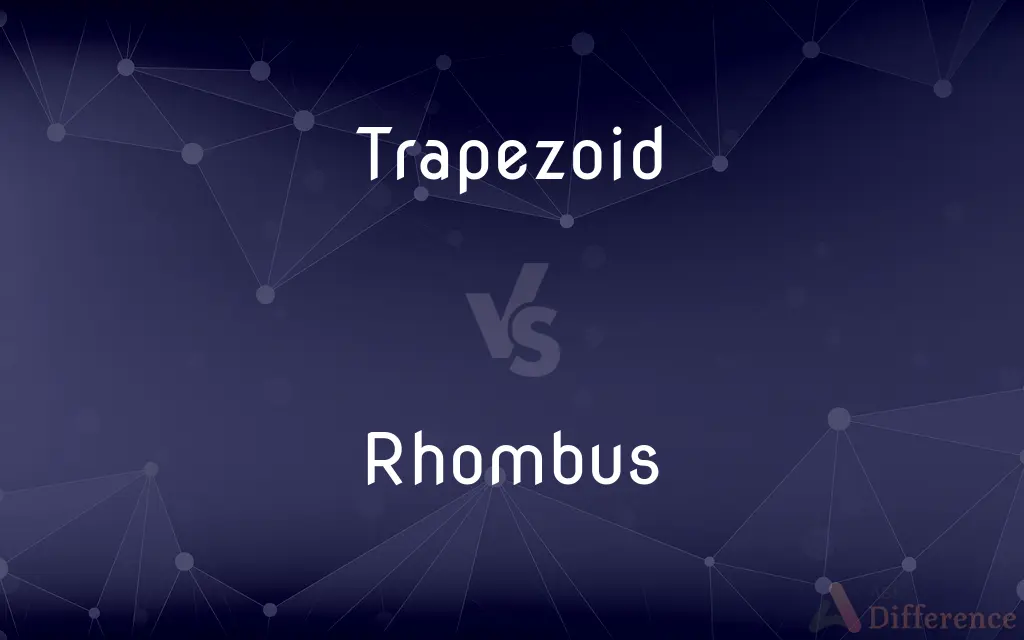Trapezoid vs. Rhombus — What's the Difference?
By Maham Liaqat & Urooj Arif — Updated on March 11, 2024
A trapezoid is a four-sided figure with at least one pair of parallel sides, while a rhombus is a four-sided figure with all sides of equal length and opposite sides parallel.

Difference Between Trapezoid and Rhombus
Table of Contents
ADVERTISEMENT
Key Differences
Trapezoids are characterized by their distinct property of having a minimum of one pair of parallel sides, known as the bases. The non-parallel sides are called the legs, which can be of different lengths. The angles in a trapezoid can vary widely, and there is no requirement for them to be congruent. Trapezoids can be classified further based on their properties; for example, an isosceles trapezoid has non-parallel sides that are equal in length and base angles that are congruent, leading to a line of symmetry.
Rhombi (plural for rhombus) are equilateral quadrilaterals, meaning all four sides have the same length. However, unlike squares, the angles in a rhombus do not have to be right angles. The defining features of a rhombus include its equal sides, parallel opposite sides, and the diagonals that bisect each other at right angles. The diagonals also bisect the vertex angles, resulting in symmetrical halves.
Trapezoids and rhombi differ significantly in symmetry and balance. An isosceles trapezoid will have a line of symmetry across its axis of symmetry, while a rhombus has lines of symmetry along both diagonals, resulting in a more balanced shape. Additionally, every rhombus is a parallelogram due to its opposite parallel sides, but not every trapezoid meets this criterion.
While both trapezoids and rhombi are four-sided figures (quadrilaterals), their properties and applications in geometry differ, reflecting the diversity of shapes and forms that can be explored and utilized in various mathematical contexts.
Comparison Chart
Sides
At least one pair of parallel sides.
All four sides are equal in length.
ADVERTISEMENT
Angles
No specific angle requirements.
Opposite angles are equal.
Symmetry
Isosceles trapezoids have one line of symmetry.
Two lines of symmetry along the diagonals.
Characteristics
Non-parallel sides can be of different lengths.
Diagonals bisect each other at right angles.
Compare with Definitions
Trapezoid
Can have non-parallel sides of unequal lengths.
The trapezoid-shaped garden bed was designed with one long and one short side.
Rhombus
All sides are equal with opposite sides parallel.
The child's kite was shaped like a perfect rhombus.
Trapezoid
Defined by having at least one pair of parallel sides.
The artist's abstract painting featured a prominent trapezoid shape.
Rhombus
Diagonals bisect at right angles, not necessarily resulting in right angles at the vertices.
The rhombus-shaped tiles had diagonals that intersected at right angles.
Trapezoid
Used in various applications from architecture to design.
The trapezoidal beams provided structural support and visual interest.
Rhombus
Area can be calculated using the lengths of the diagonals.
The jeweler calculated the area of the rhombus-shaped gemstone for the setting.
Trapezoid
Area calculation involves the lengths of parallel sides and height.
To determine the field's area, the farmer calculated the dimensions based on its trapezoid shape.
Rhombus
Often considered a type of parallelogram.
A rhombus is a special case of a parallelogram with all equal sides.
Trapezoid
Isosceles trapezoids have equal non-parallel sides and base angles.
The isosceles trapezoid window added an interesting architectural element to the building.
Rhombus
Associated with symmetry and balance due to equal side lengths and angle properties.
The artist used a rhombus pattern to create a sense of balance in the mosaic.
Trapezoid
In Euclidean geometry, a convex quadrilateral with at least one pair of parallel sides is referred to as a trapezium () in English outside North America, but as a trapezoid () in American and Canadian English. The parallel sides are called the bases of the trapezoid and the other two sides are called the legs or the lateral sides (if they are not parallel; otherwise there are two pairs of bases).
Rhombus
In plane Euclidean geometry, a rhombus (plural rhombi or rhombuses) is a quadrilateral whose four sides all have the same length. Another name is equilateral quadrilateral, since equilateral means that all of its sides are equal in length.
Trapezoid
A quadrilateral having two parallel sides.
Rhombus
A quadrilateral all of whose sides have the same length.
Trapezoid
Chiefly British A trapezium.
Rhombus
An equilateral parallelogram, especially one having oblique angles. Also called rhomb.
Trapezoid
(Anatomy) A small bone in the wrist, situated near the base of the index finger.
Rhombus
(geometry) A parallelogram having all sides of equal length.
Trapezoid
(Sports) An area in the shape of a trapezoid marked behind the goal line and the goal in ice hockey, where the goalie is allowed to play the puck.
Rhombus
The rhombus diamond, as one of the suits seen in a deck of playing cards (♦ or ♦).
Trapezoid
A (convex) quadrilateral with two (non-adjacent) parallel sides.
Rhombus
In early Greek religion, an instrument whirled on the end of a string similar to a bullroarer.
Trapezoid
A convex quadrilateral with no sides parallel.
Rhombus
Any of several flatfishes, including the brill and turbot, once considered part of the genus Rhombus, now in Scophthalmus.
Trapezoid
(anatomy) The trapezoid bone of the wrist.
Rhombus
Snails, now in genus Conus or family Conidae.
Trapezoid
A plane four-sided figure, having two sides parallel to each other.
Rhombus
Same as Rhomb, 1.
Trapezoid
A bone of the carpus at the base of the second metacarpal, or index finger.
Rhombus
A parallelogram with four equal sides; an oblique-angled equilateral parallelogram
Trapezoid
Having the form of a trapezoid; trapezoidal; as, the trapezoid ligament which connects the coracoid process and the clavicle.
Trapezoid
Of or pertaining to the trapezoid ligament; as, the trapezoid line.
Trapezoid
A quadrilateral with two parallel sides
Trapezoid
The wrist bone between the trapezium and the capitate bones
Common Curiosities
Are all trapezoids symmetrical?
No, not all trapezoids are symmetrical. Only isosceles trapezoids, which have equal non-parallel sides, exhibit a line of symmetry.
Can a rhombus have right angles?
Yes, a rhombus can have right angles. When all angles are right angles, the rhombus is also a square.
Are the diagonals of a rhombus always equal?
The diagonals of a rhombus are not equal but bisect each other at right angles.
What makes a rhombus unique among quadrilaterals?
A rhombus is unique for its equal side lengths and the properties of its diagonals, setting it apart from other quadrilaterals with its balance and symmetry.
What role do the angles play in distinguishing a trapezoid from a rhombus?
In a trapezoid, the angles can vary widely and are not necessarily congruent or complementary, whereas in a rhombus, opposite angles are equal, contributing to its symmetry.
How do the properties of a trapezoid and a rhombus differ in practical applications?
The properties of trapezoids and rhombi lead to different practical applications, such as trapezoidal shapes in architecture for structural variety and rhombus patterns in design for balanced aesthetics.
Can a figure be both a trapezoid and a parallelogram?
A figure cannot be both a standard trapezoid and a parallelogram because parallelograms require both pairs of opposite sides to be parallel, while trapezoids only require one pair.
How do the diagonals of a rhombus enhance its properties?
The diagonals of a rhombus bisect each other at right angles and also bisect the vertex angles, which contributes to the rhombus's rotational symmetry and its characteristic properties.
Is it possible for a trapezoid to be a rhombus?
No, a trapezoid cannot be a rhombus because a rhombus requires all four sides to be equal, while a trapezoid only needs one pair of parallel sides.
Why is the area formula for a trapezoid different from that of a rhombus?
The area formulas differ due to their geometric properties; a trapezoid's area depends on the average of the parallel sides and the height, while a rhombus's area is determined by the product of its diagonals' lengths.
Can the length of the sides of a trapezoid help identify its type?
Yes, in an isosceles trapezoid, the non-parallel sides (legs) are of equal length, which distinguishes it from a regular trapezoid where the leg lengths can vary.
Is it possible for a trapezoid to have parallel legs?
No, by definition, a trapezoid must have only one pair of parallel sides. If the legs (non-parallel sides) were also parallel, it would be considered a parallelogram.
What is the significance of the perpendicular bisectors in a rhombus?
The perpendicular bisectors of a rhombus, formed by its diagonals, are significant because they divide the rhombus into four congruent right triangles, aiding in various geometric proofs and calculations.
How do the properties of trapezoids and rhombi apply in real-world scenarios?
The properties of trapezoids are often utilized in architectural designs and engineering, providing structural diversity, while the properties of rhombi are used in art, design, and tessellations, offering aesthetic balance and symmetry.
Can a rhombus be classified as any other type of quadrilateral?
Yes, a rhombus is a special type of parallelogram where all sides are equal in length, and it can also be classified as a square if all its angles are right angles.
Share Your Discovery

Previous Comparison
Histopathology vs. Cytopathology
Next Comparison
Wig vs. WagAuthor Spotlight
Written by
Maham LiaqatCo-written by
Urooj ArifUrooj is a skilled content writer at Ask Difference, known for her exceptional ability to simplify complex topics into engaging and informative content. With a passion for research and a flair for clear, concise writing, she consistently delivers articles that resonate with our diverse audience.














































